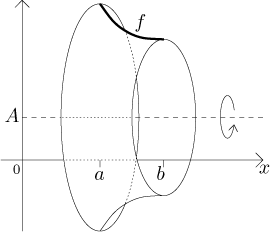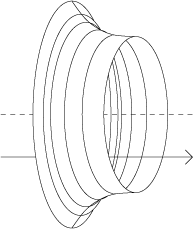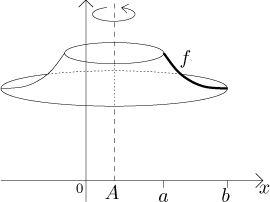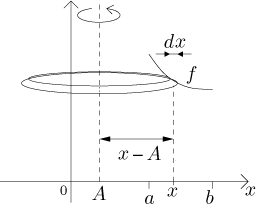
Consider the graph of a function f on an interval
Consider the surface obtained by revolving this graph around an
axis of rotation given by

To find the resulting surface area, we split the interval

When we revolve this piece of graph, we get the outer surface of a truncated
cone. To find its surface area, we multiply the size of this piece of graph
by the distance traveled by its middle, that is,

Adding up their surfaces areas we get

As usual, to ensure integrability we use the simplest way and require continuity:
Fact.
Consider the surface obtained by revolving the graph of a function f on an interval[a,b] around an axis of rotation given byy = A, whereA < min( f ). If f has a continuous derivative on[a,b], then the surface area of the surface is equal to
Consider the surface obtained by revolving the graph of f about
an axis of rotation given by

Here the procedure is almost identical to the above. We split the graph into
little pieces corresponding to subintervals of size dx on the
x-axis. Their lengths can be calculated just like above, then we
revolve the pieces around. The only change is that now the radius of rotation
is given by

For the surface we therefore get

Thus we have the following:
Fact.
Consider the surface obtained by revolving the graph of a function f on an interval[a,b] around an axis of rotation given byx = A, whereA < a. If f has a continuous derivative on[a,b], then the surface area of the surface is equal to
Consider a parametric curve

Now we will revolve this curve in turn about a horizontal and vertical axis and find the surface area. But this will now be easy. First we find the length of a small piece of the curve using the Pythagoras rule exactly as we did when calculating curve length. Then we revolve this piece and find the circumference just like in the previous calculation, we just have to substitute the parametric expressions. Thus we get:
Fact.
Consider a parametric curvex = x(t), y = y(t) for t from[α,β]. Assume thaty(t) ≥ 0 for all t andx(t) is monotone, assume further that both functions have continuous first derivative.The surface area of the surface obtained by revolving this curve about a horizontal axis of rotation given by
y = A, whereA < min(y(t)), is
The surface area of the surface obtained by revolving this curve about a vertical axis of rotation given by
x = A, whereA < min(x(t)), is